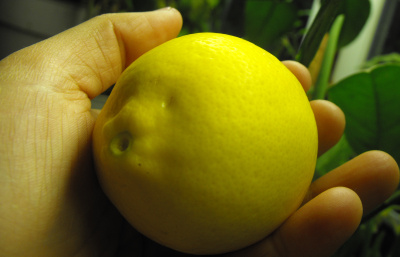
What is a dwarf citrus?
 Nearly all dwarf trees get
their size from the rootstock. For citrus trees, that's usually a
flying dragon trifoliate
orange, which stunts
the resulting tree down to around 10 to 12 feet tall.
Nearly all dwarf trees get
their size from the rootstock. For citrus trees, that's usually a
flying dragon trifoliate
orange, which stunts
the resulting tree down to around 10 to 12 feet tall.
You can use the bonsai
effect --- a small pot and occasional pruning --- to miniaturize your
tree further, down to about
4 to 5 feet.
Generally, if you want your dwarf tree to grow larger, you'll pot it up
into a 25% larger container annually. If you're happy with the
size of your dwarf tree, wait until the tree has finished ripening up
all of its fruits, then tip it out of the pot, cut off about an inch or
two around the outside of the rootball, add some fresh soil to the pot,
and put your tree back in. At the same time, cut back about a
third of the tree's branches so the top growth roughly matches the
root growth.
 The
scionwood (what you graft onto the rootstock) decides what kind
of
fruit you get. That's why you get huge lemons from a dwarf Meyer
lemon tree that's only two feet tall --- it's the variety, not the size
of the tree, that determines fruit size. Since some citrus
varieties
do better grafted on dwarfing rootstock than others, there's not the
same
range of fruit types available as dwarfs, but you can often find dwarf
lemons, limes, oranges, tangerines, and grapefruits. In some
cases, the fruits are the same size as the ones you'd find in the
grocery store, in come cases they're larger, and in some cases they're
smaller --- it all depends on the variety.
The
scionwood (what you graft onto the rootstock) decides what kind
of
fruit you get. That's why you get huge lemons from a dwarf Meyer
lemon tree that's only two feet tall --- it's the variety, not the size
of the tree, that determines fruit size. Since some citrus
varieties
do better grafted on dwarfing rootstock than others, there's not the
same
range of fruit types available as dwarfs, but you can often find dwarf
lemons, limes, oranges, tangerines, and grapefruits. In some
cases, the fruits are the same size as the ones you'd find in the
grocery store, in come cases they're larger, and in some cases they're
smaller --- it all depends on the variety.
Which brings me to the
final question I often get about dwarf citrus
--- can you grow one from seed? You can probably answer that
question yourself from the data I've already given you. Remember,
the rootstock determines how big the tree is and the scionwood is
responsible for the fruits. So, if I plant a seed from my dwarf
Meyer lemon tree, the offspring is only going to get its DNA from the
scionwood and will turn into a full-size Meyer lemon tree.
| This post is part of our Dwarf Citrus lunchtime series.
Read all of the entries: |
Want more in-depth information? Browse through our books.
Or explore more posts by date or by subject.
About us: Anna Hess and Mark Hamilton spent over a decade living self-sufficiently in the mountains of Virginia before moving north to start over from scratch in the foothills of Ohio. They've experimented with permaculture, no-till gardening, trailersteading, home-based microbusinesses and much more, writing about their adventures in both blogs and books.
Want to be notified when new comments are posted on this page? Click on the RSS button after you add a comment to subscribe to the comment feed, or simply check the box beside "email replies to me" while writing your comment.

We did try to grow a dwarf tangerine, but the plant we got had (I think) sprouted from the rootstock. It was all thorny and after two years of waiting with no fruit, I gave up on it.
I'll post more about variety selection on Friday, but while researching for this week's lunchtime series, I discovered that sour citrus are a lot easier to grow inside than sweet citrus. The latter need hot temperatures during ripening that it's often hard to manage in a winter house. So, the problem might not be your fault....